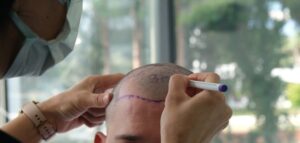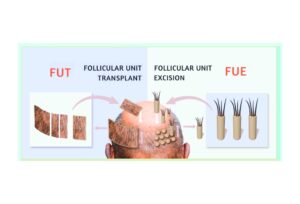If you are considering undergoing a hair transplant, it’s best to educate yourself before you commit to the surgery, so you have realistic expectations going in. One thing to be especially mindful of is the timeline of growth and what you can expect in terms of results.
When you’re just in the early stages of hair transplant research, you may be surprised to learn that it won’t restore your full head of hair immediately. Why? Well, it takes time for your newly transplanted hair to resume the natural hair growth cycle.
People who aren’t well-educated about the post-surgical timeline may be initially frustrated or discouraged when they don’t see new hair coming in right away. In this post, we will discuss the typical timeline of hair growth following hair restoration surgery. You’ll also learn what qualities make someone a good candidate, as well as what to expect both immediately after the procedure and in the months to come.
What Is an FUE Hair Transplant?
Widely recognized as the most cutting-edge hair transplant option, follicular unit excision (FUE) is a technique in which a doctor removes tiny groupings of hair from a donor area and reinserts them into the balding areas on the top and sides of the head.
FUE produces highly natural-looking results when performed by a skilled surgeon. Unlike older methods of hair restoration surgery, the procedure does not require stitches or leave patients with a noticeable scar.
Who Is the Best Candidate for a Transplant?
If you’re researching hair transplants, understand that candidacy requirements differ among hair restoration surgeons. However, here are some general guidelines to give you a better idea of the ideal candidate.
- Quality of the donor hair: If you have widespread hair loss across your entire scalp, you may lack enough donor hair to qualify for hair restoration.
- Predictable hair loss pattern: For most hair transplantation surgeries, there is a better chance of a successful outcome for slightly older patients whose pattern of hair loss is easier to predict.
- Underlying cause of your hair loss: Several factors can influence why people lose their hair. For example, if your hair has fallen out due to stress, as opposed to genetic male and female pattern balding, a hair transplant may not be ideal for you.
What to Expect Immediately Following a Hair Transplant
There are a few things you should know about the first few days after your procedure.
1. Donor and Recipient Discomfort
As with any surgical procedure, it’s very common to experience some general discomfort for the first few days following a transplant. However, most patients report their discomfort is mild enough that they can control it with over-the-counter pain medication.
2. Bleeding
Sporadic bleeding at the donor and recipient sites may continue for the first week after your surgery, though it should only be minor and not continuous. To staunch any bleeding, apply gentle pressure with a damp washcloth for at least five minutes. If you are concerned that the amount of blood seems excessive, call your surgeon.
3. Swelling
Swelling is another normal side effect of a transplant, and in most cases, it is minor. To lessen the swelling you experience, you can sleep with your head elevated, apply icepacks and avoid vigorous physical activity.
4. Graft Scabbing
Once the bleeding and swelling subside, it’s normal for small scabs to form around the individual implant grafts. Your surgeon will provide you with detailed post-surgical instructions, but the most important thing to remember is not to pick at your scabs, as this can damage or even dislodge your grafts.
Ways to Manage Post-Transplant Side Effects
You can minimize the above-listed side effects by following a few simple tips.
1. Avoid intense physical activity for a few days after your procedure. Jumping right back into a workout routine can trigger bleeding and swelling, and may even dislocate the grafts.
2. Follow your surgeon’s post-procedure instructions to the letter, including taking all medications as prescribed.
3. Avoid styling or use of non-essential hair care products for a few weeks after your transplant. Putting chemicals on your scalp, combined with the irritation styling causes, can lead to less-than-ideal outcomes.
4. Return to your doctor for any follow-up appointments. Many patients don’t realize how essential this is for ensuring the success of your transplant. Doctors can detect signs of an issue before it gets worse.
Your Hair Transplant Timeline
Once your donor and recipient sites have healed, you’ll have a better idea of how your hair growth will occur. Though healing and progress vary by individual, there are three overall phases of hair growth following a transplant:
- Months 0-4: Dormancy
The months that immediately follow your transplant can be disheartening, especially if you don’t know what to expect. During this phase, the newly transplanted hairs fall out. Fortunately, this is a temporary phase that’s necessary for healthy hair growth. Once the new hair has been shed, the follicles enter a resting stage. This phase is called telogen, and it’s an entirely normal part of the natural hair growth cycle. It lasts between a few weeks to a few months, depending on the patient, at which point new hairs will emerge and the cycle can begin again. - Months 4-8: Emergence
The long-awaited moment has finally arrived – you’re starting to see new hair growing in the recipient area. At this stage of the process, your transplanted follicles have moved from the dormant telogen phase into anagen, which is the phase of the hair growth cycle when active growth takes place. The new hairs will initially be fine and thin, but they will thicken over time. During this phase, both the donor and recipient sites should be fully healed, and you should not see any noticeable evidence of the transplant. - Months 8-12: Maturation
The final stage in the first year after an FUE hair transplant is called the maturation period. During this time, the fine hairs become thicker, and you should be able to see 75 to 80 percent of your final outcome. At this stage, you should have longer and denser hair that you can comb, cut and style as you please. - One Year and Beyond
Just as above, the results you see the second year following transplant will vary. However, after two full years, the full results should be visible. Depending on the extent of your original hair loss, you may wish to begin considering an additional transplant session at this point. If you’re pleased with your results overall but wish you had more coverage, this is a common choice. Since your transplanted hair should now be fully into the natural hair growth cycle, you should expect a period of overall growth for approximately three years. This is the typical length of the anagen phase, after which the hair will go through the other two stages, which are called catagen and telogen.
The Best Hair Restoration Surgeons
Now that you know what to expect during the hair restoration timeline, you may be ready to explore next steps with a qualified and experienced hair transplant surgeon. Hair transplantation innovator Dr Robert Jones and his partner, Dr Jonathan Huber are internationally recognized for the results they have helped patients achieve with FUE surgery.
As doctors who have dedicated 100 percent of their practice to hair restoration, they provide consistently outstanding and natural-looking hairlines to men and women around the world who are embarrassed about their hair loss. Contact the Toronto Hair Transplant Surgeons to schedule a complimentary consultation.

















